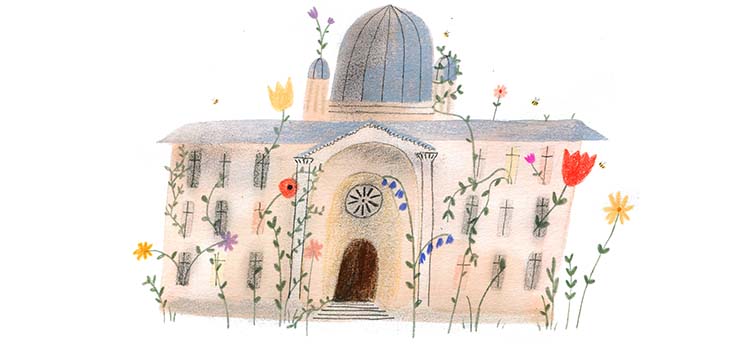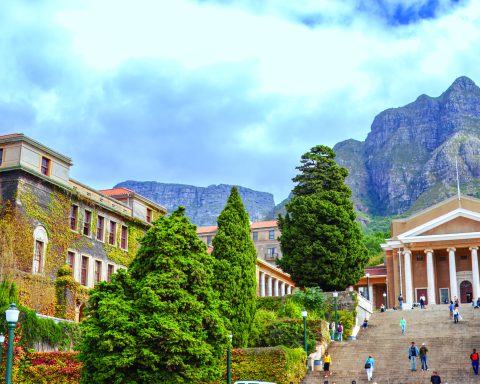“I have such a grin on my face talking about this,” Annie Quadros says, recalling her three years at Dawson College and her experience with its Living Campus at Québec’s largest CEGEP.
While there are lots of living things on this 12-acre greenspace in the heart of downtown Montréal – like butterfly sanctuaries, insect resorts, beehives, meadows and other microhabitats – the 21-year-old recent graduate emphasizes that “the Living Campus is not necessarily something that is always tangible.” Rather, these opportunities to connect with nature are the catalyst that brings life to education and education to life. In the process, it also creates change agents like Quadros with the competencies to tackle complex 21st century challenges.
Dawson was not always a happy place, explains Chris Adam, Dawson’s sustainability coordinator. In 2006, a gunman opened fire in the cafeteria, killing one student and injuring several others. “The shooting itself galvanized us as an institution,” he says. “And then we had to look at how do we bring people together?” Inviting nature back into an urban setting seemed like a good place to start. The Peace Garden was created. Occupying an entire corner of Dawson, it began as a symbol. “It was a great metaphor for what was needed,” Adam says.
Now, more than a decade after the incident, the Peace Garden is more than a place for quiet reflection; it is an integrated part of the Living Campus, where the entire envelope of the property is an active learning laboratory spanning disciplines for Dawson’s 10,000 students. Field trips on the school grounds investigate microhabitats, beehives and fossils that are embedded in the old stone structure of the former convent.
Every year, hundreds of monarch butterflies are released by students, faculty and administration in the Peace Garden to start their journey to the mountains of Mexico. As with all of Dawson’s programs, the butterfly program has a tangible goal: saving the threatened monarchs from extinction. But as Quadros said, it’s the intangibles of “people from different corners relating on the commonality of working together for a group project” that is the heart of the Living Campus.
The butterfly program is one of several ways in which the Living Campus reinforces the interconnection between people and nature. The Peace Garden is part of the nectar corridor, containing the milkweed needed by monarch butterflies and caterpillars. The soil from gardens is generated from the on-site composting program, one that benefits not only the butterflies but also the student gardeners like Quadros. “There is scientific proof that touching soil actually releases certain hormones that encourage happiness,” she says.
Caring for tiny chrysalises and caterpillars for several weeks creates a deep connection and concern for the butterflies as they face the increased risk of hurricanes due to climate change on their journey southward. Knowing that one flower with nectar can help a butterfly travel another 100 kilometres underscores the need for an urban pollinator garden. “It’s a wonderful way to bring complex issues right home,” says Adam. Of course, nature can throw curve balls like when the Dawson butterflies were threatened with a parasite. The biology students jumped on board to find a way to stop the transmission of the disease, and now the butterflies are checked so that only healthy ones are released from the Peace Garden.
Many campuses across Canada are becoming more conscious of the environment, but Dawson’s mission is “to be a leading Canadian educational institution in promoting and practicing sustainability in all its endeavours.” The Dawson people are certainly good environmental stewards: reducing greenhouse gas emissions by more than 50 per cent in the past six years and committed to achieving carbon neutrality; composting 600 kilograms of cafeteria and other food waste annually; and attracting birds and insects rarely seen in downtown Montréal back to their natural habitat.
These are worthwhile endeavours in their own right. But what sets Dawson apart from many other campuses is linking sustainability to happiness and well-being, and how this connection helps build the kind of leaders the world needs now.
Adam works closely with Catherine O’Brien, an associate professor in education at Cape Breton University. O’Brien coined the term “sustainable happiness” over 10 years ago, now adopted globally by international organizations including the Danish Happiness Research Institute. “Sustainable happiness is not just about our own well-being, but recognizing how our own happiness is inextricably linked to other people, species and the ecosystems that sustain us,” she says. The Living Campus explicitly makes these connections for students and staff, fostering the development of change agents and leaders who have the capacity to address complex challenges, to work collaboratively across disciplines and apply sustainability through an education vision of well-being for all.
As Quadros found, contributing to positive change creates a culture of hope, happiness and well-being. As the first director of sustainability in the student union, she revitalized the composting program. There are now composting stations in 24 locations, and teachers bring their classes on field trips to see composting in action. The time required for composting was cut significantly by engineering students who invented a shredder to break up food. Each composter has three chambers so students can see the progress at every stage of composting – from food scraps gathered by students across disciplines in the first chamber to finished soil in the third – and understand how the apple they discard breaks down to become soil to grow flowers for their insect and bird tenants, and vegetables for their weekly harvest market. “It gives you a sense of how everything is connected,” Quadros says. She says students often start out “grossed out” by composting but quickly become intrigued and more connected to the Living Campus.

O’Brien says that while there are pockets of excellence across Canada, Dawson’s Living Campus has been more innovative than most. It creates countless opportunities for students to take leadership roles as they create new projects. Says Quadros: “Every day is a different learning experience.”
The bee project was started by two of Adam’s students who wrote a feasibility study to integrate honey bees on Dawson’s rooftop garden. An annual challenge has inter-disciplinary teams (not just in the physical education class) running, cycling and swimming 1,249 kilometres, which is the distance 12 female bees travel to produce one teaspoon of honey. The prize for completion? One teaspoon of honey. The honey is also sold on campus, labels being designed by the graphic arts department – a social enterprise that recognizes the fruits of another species’ labour.
As O’Brien points out, the world has changed, and education needs to instil 21st century competencies such as creativity, innovation, critical problem solving, collaboration and entrepreneurship while modelling sustainability. Another of Dawson’s innovations is the world’s first sustainable happiness certificate for staff and faculty. Adam says this includes an exploration of how their own happiness, like their morning coffee, is linked to others’ well-being. He cites a simple example: Shade-grown coffee protects the same birds that participants enjoy at their country place when they fly south. “Then [the bird] wins too,” Adam says.
Even during Quadros’s relatively short time at Dawson, she saw more and more disciplines escape the four walls of the classroom and breathe new life into learning. “You need people from all over the place, people from different programs and backgrounds, so you can act together with different perspectives,” she says.
“I think it’s beautiful.”







